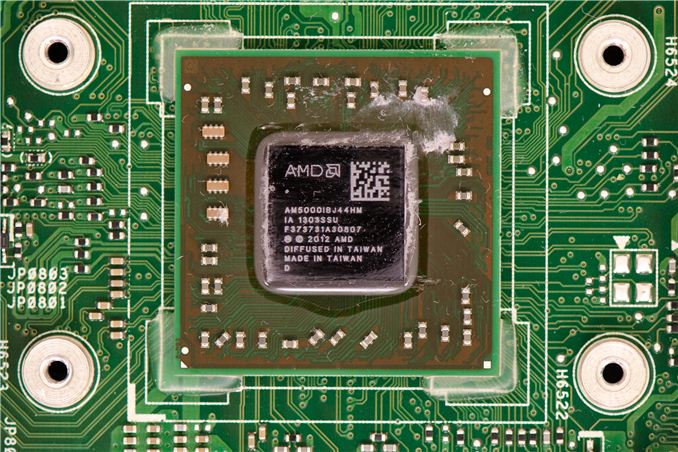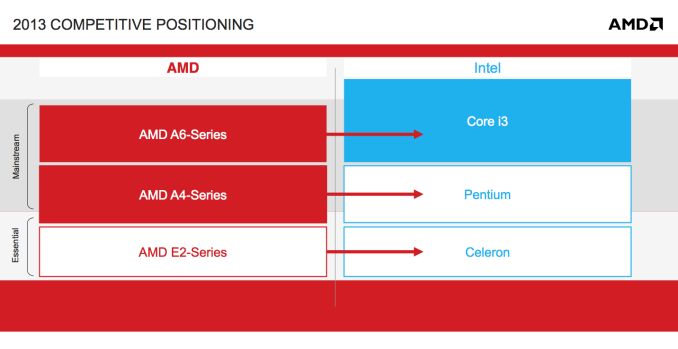The Kabini Deal: Can AMD Improve the Quality of Mainstream PCs with Its Latest APU?
by Anand Lal Shimpi on May 24, 2013 1:45 PM EST
There are two non-negotiables in building a PC these days: the cost of Intel silicon and the cost of the Windows license. You can play with everything else but Intel and Microsoft are going to get their share. Those two relatively fixed costs in the PC bill of materials can do one of two things: encourage OEMs to skimp on component cost elsewhere, or drive the entire ecosystem to supply higher quality components at lower prices. If you’ve been following the PC industry for the past decade, I think we’ve seen more of the former and less of the latter.
Apple occupying the high-end of the notebook PC space has forced many OEMs to reconsider their approach, but that’s a more recent change. What AMD seems to offer is an easier path. AMD will take less of the BoM, allowing OEMs to invest those savings elsewhere - a move Intel will never make. Given how much pressure the PC OEMs have been under for the past few years, AMD’s bargain is more appealing now than it has ever been.
With Llano and Trinity, AMD’s story was about giving up CPU performance for GPU performance. With Kabini, the deal is more palatable. You only give up CPU performance compared to higher priced parts (you gain performance compared to Atom), and you get much lower power silicon that can run in thinner/lighter notebooks. Typically at the price points Kabini is targeting (sub-$400 notebooks), you don’t get pretty form factors with amazing battery life. AMD hopes to change that.
While AMD hasn’t disclosed OEM pricing on Kabini (similarly, Intel doesn’t list OEM pricing on its mobile Pentium SKUs), it’s safe to assume that AMD will sell Kabini for less than Intel will sell its competing SKUs. If Kabini’s die size is indeed around 107mm^2, that puts it in the same range as a dual-core Ivy Bridge. AMD can likely undercut Intel a bit and live off of lower margins, but there’s one more component to think about: Ivy Bridge needs its PCH (Platform Controller Hub), Kabini does not. As a more fully integrated SoC, Kabini’s IO duties are handled by an on-die Fusion Controller Hub. Intel typically charges low double digits for its entry level chipsets, which is money AMD either rolls into the cost of Kabini or uses as a way of delivering a lower total cost to OEMs.
Traditionally, OEMs would take these cost savings and pass them along to the end user. I get the impression that AMD’s hope with Kabini is for OEMs to instead take the cost savings and redeploy them elsewhere in the system. Perhaps putting it towards a small amount of NAND on-board for a better user experience, or maybe towards a better LCD.
As we found in yesterday’s article, Kabini does a great job against Atom and Brazos. However, even with double digit increases in performance, Kabini is still a little core and no match for the bigger Ivy Bridge parts. Much to our disappointment, we pretty much never get sent low end hardware for review - so to make yesterday’s NDA we had to stick with 17W Ivy Bridge and extrapolate performance from there. In the past day I grabbed an ASUS X501A system, a 15-inch entry-level machine priced in the low $300s. More importantly, it features a 35W Ivy Bridge based Pentium CPU: the dual-core 2020M.
The Pentium 2020M’s base clock speed is still relatively high at 2.4GHz, but there’s no turbo. In the low level CPU performance analysis yesterday I used a Surface Pro with a 17W 1.7GHz Core i5, but max turbo on that part can hit 2.6GHz. I actually don’t expect there to be huge CPU performance differences between the results from yesterday and what I have here but I wanted to be sure.
The bigger difference is actually on the GPU side. While a mobile Core i5 comes with Intel’s HD 4000 graphics, the Pentium 2020M gets a vanilla Intel HD GPU. At 22nm, Intel’s HD graphics is a 6 EU part with lower performance than the previous generation Intel HD 3000.
With that said, let’s see how Kabini (AMD’s A4-5000 in particular) compares to an Ivy Bridge based Pentium 2020M in CPU performance, GPU performance and finally in power.











108 Comments
View All Comments
nunomoreira10 - Saturday, May 25, 2013 - link
try turning off turbo-boostit did wonders for mine
select 99% maxprocesserspeed on power management
ssj3gohan - Friday, May 24, 2013 - link
Where did you get that platform power consumption from? Because I've done some pretty extensive measurements on my own laptop (a not-really-ultrabook Medion, i5-3317U, UM77 chipset, 4GB RAM, Samsung 840, crappy display on eDP) and I got an idle total platform power of 3.3W. Of course that's with a 3.0W TDP UM77 chipset and not one of the 4.1W TDP non-ultramobile chipsets, but I don't think the gap should be *that* big! You're saying 8.14W for your Pentium 2020M setup, there must be some power hog or some software setting that you missed.DanNeely - Friday, May 24, 2013 - link
It's a 35W CPU in a $3xx system; unlike your not-really-an-ultrabook I doubt power consumption was a major vendor concern.repoman27 - Friday, May 24, 2013 - link
"As a more fully integrated SoC, Kabini’s IO duties are handled by an on-die North Bridge."On die northbridge is nothing new. Kabini has an on die FCH—both the north and south bridges are now integrated.
repoman27 - Friday, May 24, 2013 - link
Oops, sorry DanNeely. That was supposed to be a comment, not a reply. Still getting used to the new site layout.thuejk - Friday, May 24, 2013 - link
> There are two non-negotiables in building a PC these days: the cost of Intel silicon and the cost of the Windows license.The Windows license is becoming a bit optional. With Steam on Linux, lots of indie games with Linux support, and wine emulation (Starcraft II!), running Linux is becoming possible for gamers willing to limit their game library a bit.
Calinou__ - Monday, May 27, 2013 - link
It always was optional. There were lots of games before there was Steam, too.But well, you know, that's Anandtech. If it's non-commercial then it sucks. 8)
Death666Angel - Friday, May 24, 2013 - link
100% agreed with your conclusion. While cheaper-than-Pentium Kabini laptops would be okay (and will happen), I would like to see a Kabini laptop priced the same with a slightly larger battery, better/higher-res display and maybe more RAM or a small-ish SSD at the same price than competing Intel based laptops.Gaugamela - Friday, May 24, 2013 - link
This is more like it. The previous review was just pitiful. Considering that Notebookcheck.net had a much more extensive review, Notebookreview had an awesome review with glowing conclusions to Kabini, that Tomshardware managed to make a comparison with a 35W Pentium and an i3 Ivy Bridge you guys just had to do damage control.Kabini is a great piece of hardware. Super efficient and with enough performance for the majority of users not to notice an impact in daily use. Especially if options with an SSD exist.
Considering how it competes with a 35W Pentium and how efficient it is (it puts to shame the Ivy Bridge i3) this is an awesome chip. And then there's the matter of price. Considering this is a SoC, it is much cheaper than anything that Intel has to offer.
So, yes AMD has a great product here. And you guys will have to change your tune and stop using them as punching bags.
JarredWalton - Saturday, May 25, 2013 - link
[Rolls eyes]The previous review was under a severe time crunch, and while we'd love to have performance scores from every noteworthy CPU/APU out there (hello ULV Celeron, Pentium, Core i3, Trinity...) the fact is no one ever sent us laptops with those parts, and nearly all of the laptops we've reviewed over the past two years have gone back to the manufacturers.
This follow-up isn't about damage control, it's about hoping -- praying! -- that the OEMs won't do with Kabini what they've done with every other low-cost APU out there. I'm skeptical that we can get leopard to change their spots (i.e. budget laptop manufacturers to give us decent displays and chassis to go with the Kabini/Temash SoCs), but we shall see. For the price, Kabini has something to offer, but history suggests that most OEMs will take the cost savings and cut corners everywhere else to create mediocre laptops. The best CPU/APU/SoC in the world married to a lousy design is not a compelling product.
The simple fact of the matter is that you can't handle a the reality of the price/performance equation. Kabini laptops (and Temash tablets) will need to offer either better features/quality and/or lower cost than Core i3 in order to truly impress. They'll likely sell fine regardless, just like Brazos, but speaking of Brazos I actually managed to borrow a C-50 from a friend today, and I had forgotten just how bad the experience can be. E-350 was tolerable; C-50, not so much. Compared to C-50, the A4-5000 is amazingly fast! That's the problem with living in a vacuum where you only look at the comparisons a product wins: there are a lot of options out there to consider.
If there are two laptops with the same design, features, and components at the same price, and one has Kabini A4-5000 while the other has i3-3217U, it's a tossup. We know i3-3217U will have better CPU performance, and in many cases it will have better GPU performance as well. Kabini should have a slight edge in power use. Depending on the user's needs, either laptop could be a good fit, but personally I'd take Core i3 with HD 4000 and slightly worse battery life since I rarely need 7+ hours off the mains. On the other hand, if the Kabini option has a better LCD, or an SSD, that would be enough to give it the nod. This is exactly what we said in the original review, but you keep overlooking that fact.